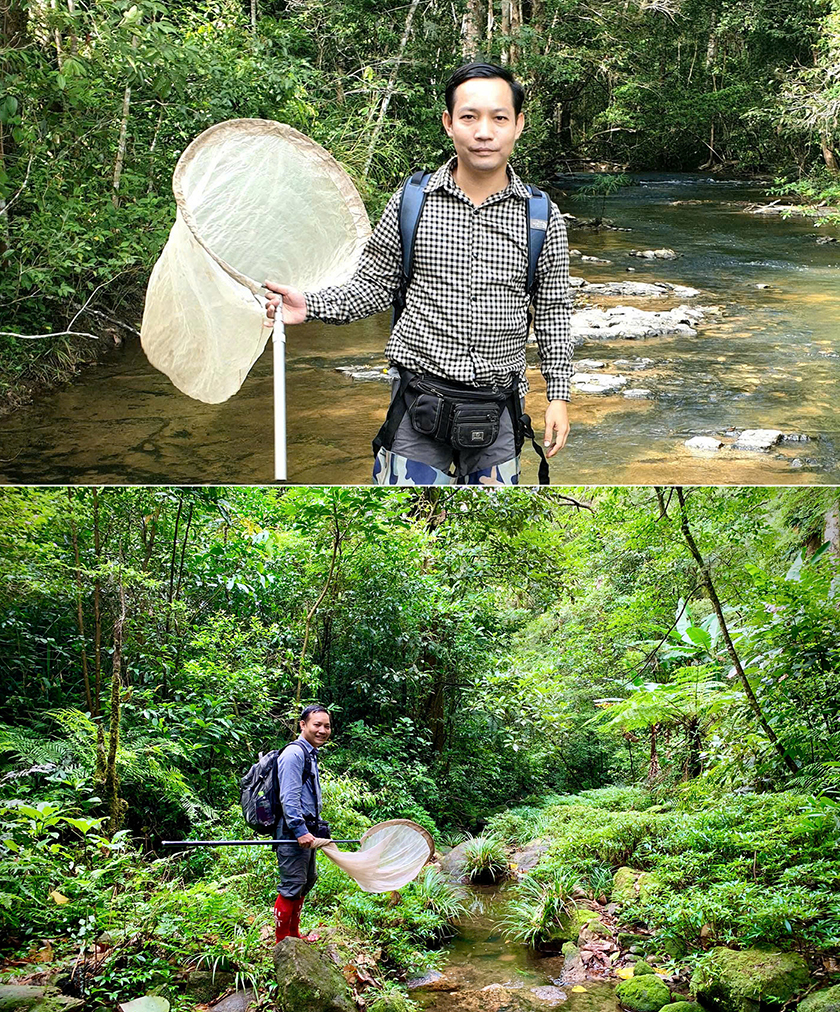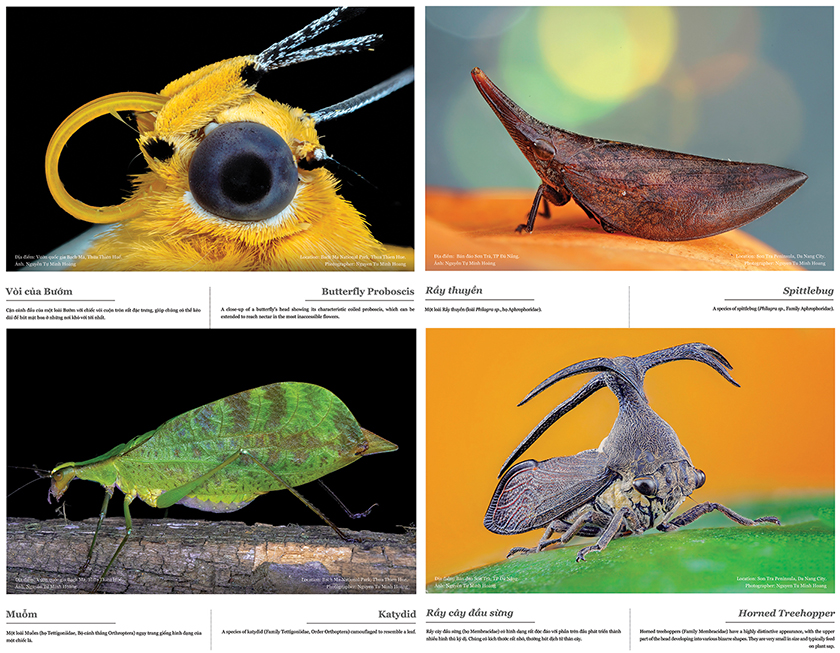A unique exhibition titled “Colorful Diversity of Vietnam’s Insects” is held from June 20 to July 13, 2025, at the Da Nang Museum.

Dr. Phan Quoc Toan, Director of the DTU Insect-Parasite Research Center, pictured by a stream
at an altitude of 1,600 meters in Vu Quang National Park, Ha Tinh - Photo: DTU
This is the first time an insect exhibition in Vietnam is jointly organized by two universities: DTU and Dalat University. The exhibition offers a rare opportunity for the public to explore Vietnam’s rich insect biodiversity and serves as a bridge between science and the community, contributing to raising awareness about nature conservation and biodiversity protection.
Let’s meet Dr. Phan Quoc Toan, Director of the DTU Insect-Parasite Research Center, to learn more about this special exhibition held during the 2025 International Fireworks Festival in Da Nang City.
What was the starting point for launching this exhibition?
The collaboration between DTU and Dalat University in organizing the exhibition “Colorful Diversity of Vietnam’s Insects” was not coincidental but stemmed from both institutions’ strengths in entomological research.
Both universities have strong research groups in entomology and possess diverse, unique insect collections. This exhibition presents a valuable opportunity for the public to admire the beauty, diversity, and uniqueness of Vietnam’s insect species.
For the first time, visitors will be able to see rare and unique insect species found only in high mountainous regions, including many endemic species exclusive to Vietnam. These have been collected and preserved in laboratories by the entomology research teams from Duy Tan University and Dalat University.

A damselfly species discovered by Dr. Phan Quoc Toan was named after the founder of DTU,
Distinguished Teacher and Labor Hero Le Cong Co, with the scientific name Coeliccia lecongcoi – Photo: DTU
Can you share more details about the insect species featured in the exhibition?
The “Colorful Diversity of Vietnam’s Insects 2025” will showcase over 100 specimen boxes of Vietnamese insects. These include large beetles, cicadas, and dragonflies typically found in well-preserved primary forests, along with many species exhibiting striking wing and body coloration. Highlights include:
? A diverse collection of over 200 species of butterflies and moths, varying in size, shape, and color. Rare specimens include the imperial swallowtail (Teinopalpus imperialis) and other giant butterflies like the emperor butterfly and orange oakleaf.
? Rare forest dragonflies such as:
+ Coeliccia duytan - the “Duy Tan Damselfly,” found only in Chu Mom Ray National Park (Kon Tum),
+ Coeliccia lecongcoi - an endemic species recorded only in Ngoc Linh (Kon Tum) and Kon Ka Kinh National Park (Gia Lai),
+ and other high-conservation-value species like Chlorogomphus nakamurai (black-winged dragonfly), C. aritai (Aritai forest dragonfly), and C. papilio (swallowtail-winged dragonfly).
? A collection of giant beetles, including:
+ The three-horned rhinoceros beetle (Chalcosoma caucasus),
+ The five-horned rhinoceros beetle (Eupatorus gracilicornis),
+ The rare Cheirotonus jansoni (known locally as the “flying crab” beetle).
+ These are rare beetles living only in intact highland forests and are indicators of pristine forest ecosystems in Vietnam.
? Other fascinating insect collections, including stick insects, praying mantises, grasshoppers, and elephant-nosed cicadas, showcasing a wide variety of species and taxonomic groups.
In addition to the specimens, the exhibition features over 150 photographs and posters that provide deeper insights into the beauty and ecological importance of insects.
Can you share the challenges in assembling these collections?
Field research and specimen collection in mountainous forests is extremely challenging and strenuous, but also incredibly fascinating. After obtaining permits to work in national parks and nature reserves, we had to carry research equipment, tents, tarps, food, and hike to remote mountain areas for extended camping and data collection.
Working in the forest comes with many dangers - flash floods, landslides, and frequent encounters with snakes, leeches, and ticks. Only true passion drives scientists to persevere in such conditions for meaningful results.
We used multiple methods to collect specimens and had to process and preserve them on-site before conducting a second preservation phase in the lab. Every step had to be done meticulously to keep the insects intact - with wings, bodies, and vibrant colors preserved.

A wide array of Vietnamese insect species on display at the exhibition – Photo: DTU
What messages do you hope to convey through this exhibition?
Insects are among the most important invertebrate animal groups - not just for the natural world but also for human life. However, they remain underappreciated despite being essential to ecosystems.
The exhibition “Colorful Diversity of Vietnam’s Insects” offers an engaging and visually rich way for the public to learn about the roles insects play, their beauty, and how we should relate to them and nature as a whole.
Visitors will learn how insects benefit humanity in areas such as:
- Medicine and food,
- Art and design,
- Biotechnology,
- Agriculture,
- Medicine, and
- Environmental protection.
Held alongside the 2025 International Fireworks Festival, this exhibition will give international visitors a chance to appreciate Vietnam’s unique insect fauna and join in raising environmental and biodiversity conservation awareness.
The “Colorful Diversity of Vietnam’s Insects” exhibition will also feature many entomology researchers from DTU and Dalat University. Special academic seminars will be held during the exhibition with the participation of:
- Dr. Phan Quoc Toan (on forest insects and DTU’s insect collections),
- Dr. Tosaphol Saetung Keetapichayakul (on aquatic insects at DTU),
- Dr. Kim Junggon (on pests like mites, leafhoppers, and stink bugs at DTU),
- Dr. Lee Hyun Suk (on agricultural insects and Dalat University’s collections).
Surely, the exhibition “Colorful Diversity of Vietnam’s Insects” will inspire younger generations to pursue careers in entomology, biology, biotechnology, and environmental science - to help protect biodiversity and our precious natural ecosystems.
Thank you, Dr. Phan Quoc Toan, for these fascinating insights!
(Media Center)